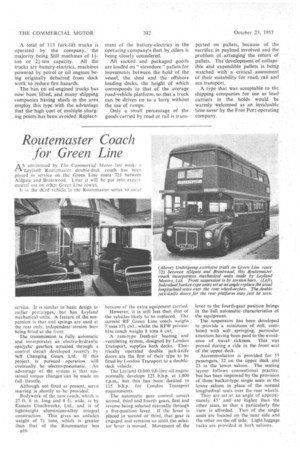_Routemaster Coach for Green Line
Page 44

If you've noticed an error in this article please click here to report it so we can fix it.
A total of 113 fork-lift trucks is operated by the company, the majority being Still machines of 14ton or 21-ton capacity. All the trucks are battery-electrics, machines powered by petrol or oil engines being originally debarred from dock work to reduce fire hazards.
The ban on oil-engined trucks has now been lifted, and many shipping companies having sheds in the area employ this type with the advantage that the high cost of multiple charging points has been avoided. Replace
service. It is similar in basic design to earlier prototypes, but has Leyland mechanical units. A feature of the suspension is that coil springs are used at the rear only, independent torsion bars being fitted at the front.
The transmission is fully automatic and incorporates an electro-hydraulic epicyclie gearbox actuated through a control circuit developed recently by Self Changing Gears, Ltd. If this project is pursued operation will eventually be electro-pneumatic. An advantage of the system is that sustained torque changes can be made on full throttle.
Although not fitted at present, servo • steering is shortly to be provided.
Bodywork of the new coach, which is 27 ft. 6 in. long and 8 ft. wide, is by Eastern Coachworks, Ltd., and is of lightweight aluminium-alloy integral construction. This gives an unladen weight of 7-1 tons, which is greater than that of the Routemaster bus ment of the battery-electrics in the operating company's fleet by oilers is being closely considered.
All sacked and packaged goods are loaded on " stevedore" pallets for movements between the hold of the vessel, the shed and the offshore loading decks, the height of which corresponds to that of the average road-vehicle platform, so that a truck can be driven on to a lorry without the use of ramps.
Only a small percentage of the goods carried by road or rail is trans
because of the extra equipment carried. However, it is still less than that of the vehicles likely to be replaced. The current RF Green Line coach weighs 7 tons 171 cwt., whilst the RFW privatehire coach weighs 8 tons 8 cwt.
A ram-type fresh-air heating and ...ventilating system, designed by London Transport, supplies both decks. -Electrically operated double jack-knife doors are the first of their type to be fitted by London Transport to a doubledeck vehicle.
The Leyland 0.600 9.8-litre oil engine normally develops 125 b.h.p. at 1,800 r.p.m., but this has been derated to 115 b.h.p. for London Transport requirements.
The automatic gear control covers second, third and fourth gears, first and reverse being selected manually through a five-position lever. If the lever is placed in second or third, that gear is engaged and remains so until the selector lever is moved. Movement of the ported on pallets, because of the sacrifice in payload involved and the problem of arranging the return of pallets. The development of collapsible and expendible pallets is being watched with a critical assessment of their suitability for road, rail and sea transport.
A type that was acceptable to the shipping companies for use as load carriers in the holds would be warmly welcomed as an invaluable time saver by the Free Port operating company.
lever to the fourth-gear position brings in the full automatic characteristics of the equipment.
The suspension has been developed to provide a minimum of roll, combined with soft springing, particular. attention having been paid to the avoidance of travel sickness. This was proved during a ride in the front seat of the upper deck.
Accommodation is provided for 55 passengers, 32 on the upper deck and 23 in the lower saloon. The seating layout follows conventional practice. but has been improved by the provision of three bucket-type single seats in the lower saloon in place of the normal longitudinal seats over the rear wheels.
They are set at an angle of approximately 45° and are higher than the other seats, so that a particularly fine view is afforded. Two of the single seats are located on the near side and the other on the off side. Light luggage racks are provided in both saloons.




































































































